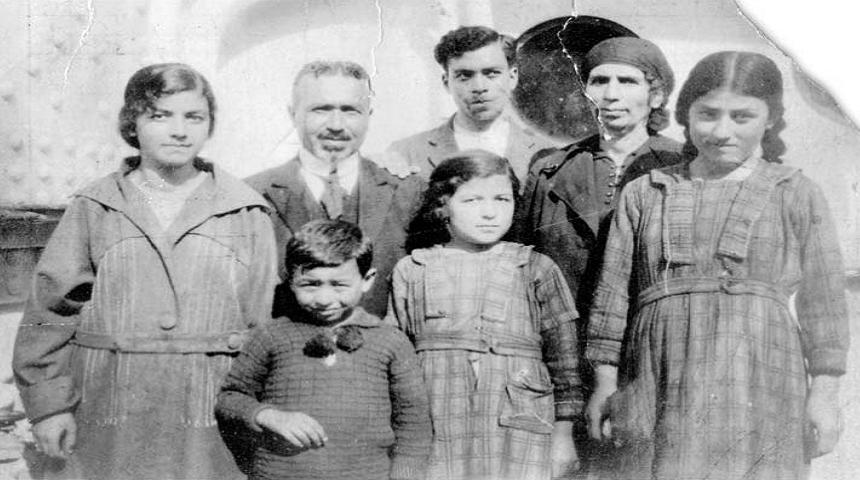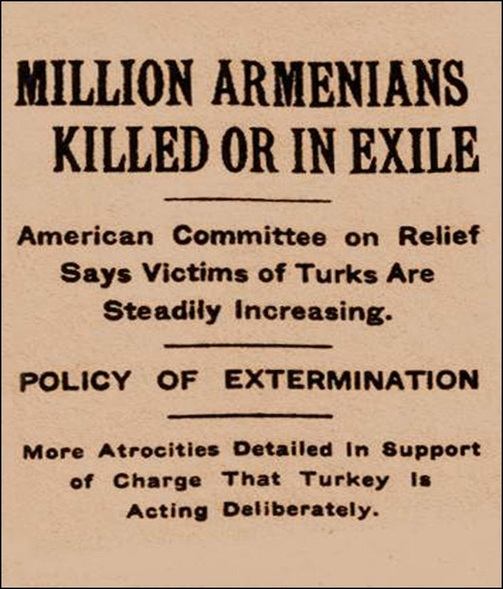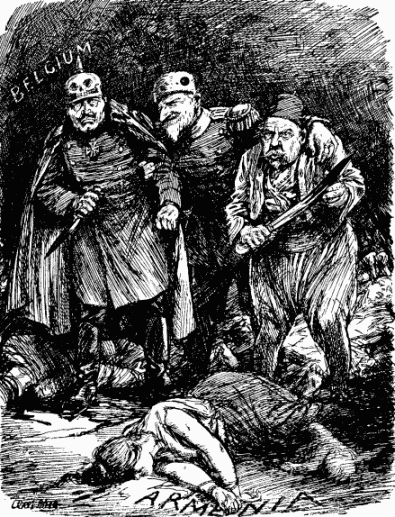GALLERY WALK:
THE ARMENIAN GENOCIDE
“Who, after all, speaks today of the annihilation of the Armenians?”
-Adolf Hitler, August 22, 1939
The Armenian Genocide is one of the wholly-forgotten parts of the First World War. Between 1894 and 1896, after demanding more ethnic autonomy and religious freedom, 300,000 Armenians were killed in what was dubbed the "Hamidian Massacres" after Sultan Abdul Hamid himself. Amidst rumors that the Armenians were aiding their ethnic brothers, the Russian, against the rival Turks, the Armenian Genocide took the lives of an estimated 1.5 million Armenians between 1914 and 1918. Click below to view the video about the genocide as a preview for the rest of the site.
By examining the map above, you can see that those who weren't killed were sent on "death walks" through the Ottoman deserts, aimed at exhausting, starving, and overexposing to the elements those who wandered from deportation center to deportation center.
News of the atrocities circled the globe. The New York Times revealed the massacre on its front pages, the British satirical magazine Punch featured the above image of Germany, Austria, and Turkey united in genocide...yet the United States did little to help until after the war.
In 1919, Major General James Harbord was sent by President Woodrow Wilson on an "ambassador's mission" to discuss the possibility of an Armenian Mandate. Put simply, he was to draw up the "pro's and con's" of creating a separate, ethnic homeland for the Armenian people and whether or not the United States should help in this creation. Upon return, Harbord made the following recommendations based on the following facts. His direct quotes are below:
REASONS THE UNITED STATES SHOULD HELP WITH THE MANDATE:
REASONS THE UNITED STATES SHOULD NOT HELP WITH THE MANDATE:
Both the British and the French proposed the following map as ideal mandate sites. Notice how the sites infringe on already-established nations. In the end, the United States DID NOT help with the mandate, and would withdraw towards a post-war, domestic focus.
In 1919, Major General James Harbord was sent by President Woodrow Wilson on an "ambassador's mission" to discuss the possibility of an Armenian Mandate. Put simply, he was to draw up the "pro's and con's" of creating a separate, ethnic homeland for the Armenian people and whether or not the United States should help in this creation. Upon return, Harbord made the following recommendations based on the following facts. His direct quotes are below:
REASONS THE UNITED STATES SHOULD HELP WITH THE MANDATE:
- "The United State is morally bound..." to help.
- "America is practically the unanimous choice and fervent hope of all the people's involved."
- "America is the only hope for the Armenians."
- "It would definitely stop further massacres"...and..."provide justice."
REASONS THE UNITED STATES SHOULD NOT HELP WITH THE MANDATE:
- "The United States has prior and nearer foreign obligations..."
- We might approach "...a point of exhaustion..." with our philanthropy.
- "Other powers...have shown continued interest..." in helping the Armenians.
- "Our country would be put to great expense..."
Both the British and the French proposed the following map as ideal mandate sites. Notice how the sites infringe on already-established nations. In the end, the United States DID NOT help with the mandate, and would withdraw towards a post-war, domestic focus.
ANALYSIS QUESTIONS:
- What's one thing you now know about the Armenian Genocide?
- We know that the United States DID NOT help with the mandate. In your opinion, of the list provided by General Harbord, what was the biggest reason the American's didn't intervene?
- In our understanding of the principles of "ethnic nationalism", predict: will the Armenians get a homeland? Why or why not?
- In referencing Hitler's quote at the top, why is it important to study the Armenian Genocide? (NOTE: You can either discuss the dangers of "state nationalism" over ethnicities OR discuss why that quote from Hitler is so disturbing...)






